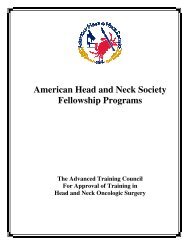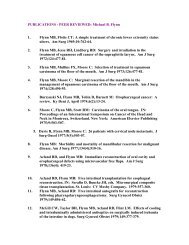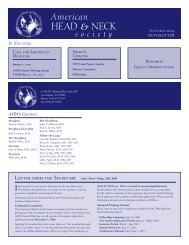Download - American Head and Neck Society
Download - American Head and Neck Society
Download - American Head and Neck Society
Create successful ePaper yourself
Turn your PDF publications into a flip-book with our unique Google optimized e-Paper software.
Oral Papers<br />
thyroglobulin level after 1st RAI treatment (2nd stimulated Tg) in the<br />
TT+CLND group was not different from that in the TT group (0.44 vs.<br />
0.69 ng/mL, P = 0.341). Also, the 3-year locoregional control rates of<br />
the TT+CLND group was not different from that of the TT group (98.3%<br />
vs. 96.5%, P = 0.368). Complication rates in the TT+CLND group were<br />
slightly higher than in the TT group, without statistical significance (P<br />
> 0.05). Conclusions: Prophylactic CLND could effectively clear the<br />
subclinical LNMs in central neck <strong>and</strong> reduce postoperative thyroglobulin<br />
level without significant increase of complications. However, prophylactic<br />
CLND had little prognostic benefit, particularly for patients with RAI<br />
treatment.<br />
S040<br />
ROUTINE PARATHYROID LOCALIZATION WITH 4-D<br />
COMPUTED TOMOGRAPHY/ULTRASOUND IN PATIENTS WITH<br />
HYPERPARATHYROIDISM. David I Kutler, MD, Rachel A Moquete, BA,<br />
William I Kuhel, MD, Eli Kazam, MD; Weill Cornell Medical Center.<br />
Background: Accurate preoperative localization of hyperplastic<br />
parathyroid gl<strong>and</strong>s increases surgical success <strong>and</strong> minimizes operative<br />
risk. 4D Computed Tomography (4D-CT) was recently shown to be highly<br />
sensitive <strong>and</strong> specific in identifying hyperplastic parathyroid gl<strong>and</strong>s in<br />
the reoperative setting. The purpose of this study is to document our<br />
decade long experience using 4D- Computed Tomography/Ultrasound<br />
(4D-CT/US) to localize abnormal parathyroid gl<strong>and</strong>s in patients with<br />
hyperparathyroidism. Study Design: This is a retrospective chart<br />
analysis of 185 patients who underwent a parathyroid localization series<br />
at Manhattan Diagnostic Radiology (MDR) <strong>and</strong> parathyroidectomy at<br />
Weill Cornell Medical Center between January 1998 <strong>and</strong> May 2009.<br />
Of the185 patients, 11 were in the reoperative setting. Results from<br />
preoperative localization studies were compared to operative findings,<br />
pathologic data <strong>and</strong> biochemical measurements to assess the sensitivity<br />
<strong>and</strong> specificity of the parathyroid localization series. Results: 4D-CT/<br />
US demonstrated 96% sensitivity <strong>and</strong> 90% specificity when the imaging<br />
studies were used to lateralize the hyperfunctioning parathyroid gl<strong>and</strong><br />
to 1 side of the neck. Furthermore, the sensitivity <strong>and</strong> specificity of the<br />
parathyroid series to localize the hyperfunctioning parathyroid gl<strong>and</strong> to<br />
a specific quadrant of the neck (ie right superior) was 82% <strong>and</strong> 92%<br />
respectively. Of the 185 patients, 4D-CT/US was felt to show a single<br />
adenoma in 146 patients. Of the 146 patients, 4D-CT/US accurately<br />
localized the adenoma to the correct side of the neck in 134 cases<br />
(92%). Multigl<strong>and</strong> disease was found in 11 patients (8%) believed to<br />
have single gl<strong>and</strong> disease. Of the 38 patient who were thought to have<br />
multigl<strong>and</strong> disease based on the results of the 4D-CT/US, multigl<strong>and</strong><br />
disease was documented in 28 patients (74%). Only a single parathyroid<br />
localization study was non-localizing <strong>and</strong> that patient was found to have<br />
single adenoma. At follow up, 175 patients (95%) were cured, 8 (4%)<br />
had persistent primary hyperparathyroidism <strong>and</strong> 2 (1%) had permanent<br />
hypoparathyroidism. Conclusion: 4D-CT/US provides greater sensitivity<br />
<strong>and</strong> specificity when compared to the historical data for sestamibi<br />
imaging. When interpreted by a skilled radiologist, 4D-CT/US facilitates<br />
accurate preoperative planning in both the primary <strong>and</strong> reoperative<br />
settings.<br />
S041<br />
INTRAOPERATIVE PARATHYROID HORMONE MONITORING IN<br />
PARATHYROIDECTOMY; IS IT MANDATORY? Aviram Mizrachi, MD,<br />
Gideon Bachar, MD, Tuvia Hadar, MD, Raphael Feinmesser, MD, Thomas<br />
Shpitzer, MD; Department of Otorhinolaryngology <strong>and</strong> <strong>Head</strong> <strong>and</strong> <strong>Neck</strong><br />
Surgery, Rabin Medical Center, Beilinson Campus, Petach Tikva, <strong>and</strong><br />
Sackler Faculty of Medicine, Tel Aviv University, Tel Aviv, Israel.<br />
Objective: To determine the value of intraoperative parathyroid<br />
hormone (IOPTH) monitoring in curative parathyroidectomy. Design:<br />
Retrospective series. Setting: University-affiliated tertiary medical<br />
center. Patients <strong>and</strong> Methods: Two hundred forty consecutive patients<br />
surgically treated for primary hyperparathyroidism were divided into 3<br />
groups by preoperative <strong>and</strong> intraoperative diagnostic modalities: group 1<br />
(n=109) - technetium 99m sestamibi (MIBI), ultrasonography, <strong>and</strong> IOPTH<br />
monitoring; group 2 (n=102) - ultrasonography <strong>and</strong> MIBI; group 3 (n=29) -<br />
ultrasonography <strong>and</strong> IOPTH monitoring. The sensitivity <strong>and</strong> specificity of<br />
each combination were compared. Results: Group 1: Ultrasonography<br />
<strong>and</strong> MIBI were concordant in 97% of cases, <strong>and</strong> additional IOPTH<br />
monitoring improved the success rate in the 3 discordant cases. Group<br />
www.ahns.info<br />
2: Ultrasonography <strong>and</strong> MIBI were concordant for the same site in<br />
95% of cases. Group 3: Ultrasonography had a sensitivity of 89% <strong>and</strong><br />
a positive predictive value (PPV) of 96%. IOPTH monitoring increased<br />
the sensitivity to 96%, with no change in the PPV. Operative time was<br />
significantly longer (P








